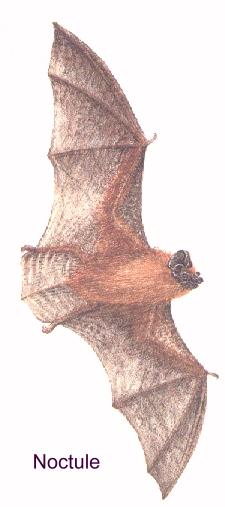Some Facts about Bats
-
Bats are the only flying mammals. They have fur, and give birth to live young.
They have been on the Earth for about 50 million years. Individuals can live
up to 30 years.
-
Bats eat only live insects. Our smallest species, the Pipestrelle may eat as many
as 3000 per night!
-
Bats are not blind. In fact they have quite good eyesight. However they
use sophisticated echo-location (sonar) for hunting prey at night.
-
There are fourteen species of bat which breed in Britain, the commonest
being the Pipestrelle which weighs in at just 5g (less than
a 2p coin), and will fit easily into a matchbox.
-
The largest British bat is the Noctule which weighs about 30g or as much as
three £1 coins. They have a wingspan of about 35cm.
-
Their wings are formed from their "fingers" and "fore-arms" which have
become extended compared to most mammals, and have a membrane of skin
stretched between them.

 Here are the Pipestrelle and the Noctule
The former, our smallest bat, must eat about 3000 insects
in one night in order to maintain weight in the breeding season.
The latter is our biggest bat, and is a fairly common species.
Here are the Pipestrelle and the Noctule
The former, our smallest bat, must eat about 3000 insects
in one night in order to maintain weight in the breeding season.
The latter is our biggest bat, and is a fairly common species.
In summer, females form Breeding Colonies, joining together in large
groups,or Maternity Roosts. These may be located in an old building or
roof space of a house etc.
Bat Recognition
Much like birds, bat types may be recognised as much from where they hunt
as from their visual shape.
For instance, the common "Pip" will be found mostly hunting for insects
above trees or hedgerows. The Noctule will be found in more open areas,
away from trees, and the Daubenton's, sometimes called the Water Bat will
be seen to skim the surface of a pond or lake. These are easily spotted if
the beam from a powerful torch is shone low across the water. This does not
appear to upset their feeding routine.
Another popular method of identifying bat species is to make use of a bat
detector.
Bat Detectors.
Bat detectors are an essential piece of kit for the keen bat watcher. They detect the ultrasonic sounds which the bats use for echo-location, and convert them to a lower frequency suitable for human ears. For the technically minded, use is made of a balanced mixer to do the frequency conversion, in conjunction with a local oscillator which has a calibrated dial to enable one to "tune in" to the individual bat's frequency.
The fact that differing bat species have different ultrasound frequencies provides a good guide to the type of bat being monitored. The more common Pipestrelle emits its
echo-location signals on a frequency of about 45 kHz, whereas the Noctule bat uses a lower frequency of about 25 kHz or so.
A simple detector can either be purchased or built by anyone with a little knowledge of electronics. Prices vary, but start at about £100 for a ready-made model, or a kit can be obtained for about £30. Inspection on the web pages which are linked below, give a variety of types and models available. I recently built a kit suppled by Magenta for £29, which performs equally as well as commercial models at around £100.
There are some really sophisticated boxes on the market these days. Digital technology is extensively used to provide such functions as real-time sound expansion, which enables the operator to examine each bat sound in minute detail.
Recognising Bat Sounds
When bats use echo-location to hunt prey, the sounds emitted are varied as they approach their target. The Pulse Repetion Frequency (No. of pulses per decond) changes with distance, becoming much higher as the target insect comes closer. Presumeably, a higher PRF gives more accurate targeting due to better resolution. The experienced bat observer soon learns the characteristic 'Zip' sound from the detector, as the insect meets its demise. Much other analysis may be carried out with expansion techniques using a PC to do the processing and to give a graphical display or Sonogram.
There is an excellent CD which contains a whole host of British bat sounds (suitably converted to frequencies within the human hearing range). It comes with a very comprehensive technical manual which describes what is going on in great detail.
Product details:
Title: The Bat Detective - A Field Guide to Bat Detection
Authors: Brian Briggs & David King
Publisher: Stag Electronics.
ISBN (CD): 5 032796 005629 (Book): 0 9532426 0 9
Sound Samples.
Here are some recorded bat echo-location sounds for the Pipestrelle and the Noctule bat.
Make sure you have sound on!

 Here are the Pipestrelle and the Noctule
The former, our smallest bat, must eat about 3000 insects
in one night in order to maintain weight in the breeding season.
The latter is our biggest bat, and is a fairly common species.
Here are the Pipestrelle and the Noctule
The former, our smallest bat, must eat about 3000 insects
in one night in order to maintain weight in the breeding season.
The latter is our biggest bat, and is a fairly common species.